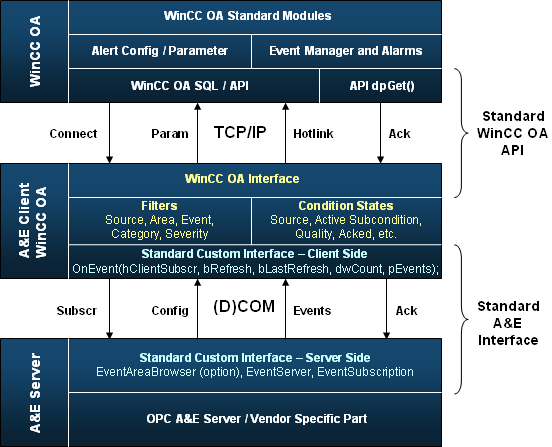Functionality and concept description
The interaction of WinCC OA and OPC A&E looks as follows (whereas the OPC A&E can be from any producer , for example, that of WinCC OA):

A OPC A&E server only manages active alerts and events (A&E). OPC A&E clients report to server via (D)COM (via a subscription) and can thereby request filtered data. The OPC A&E client of WinCC OA II can process alerts/events from several OPC A&E servers.
The OPC A&E client can configure itself widely (see also Configuration of the OPC A&E client).
The alerts and events that the WinCC OA OPC A&E client receives from an OPC A&E server are shown in the alert panel of WinCC OA.
The possibilities of the WinCC OA alert handling and the OPC A&E alert handling are very similar but not congruent. A difference is , for example, the amount of possible states for acknowledgeable alerts. WinCC OA has an additional state "CAME - WENT/unacknowledged". On the other hand the A&E knows the state "disabled". The states are translated at the alert transmission accordingly (see the following table for the different states).
| State in WinCC OA | State in OPC A&E |
| CAME / unacknowledged | Active / unacknowledged |
| WENT/ unacknowledged | Inactive / unacknowledged |
| CAME- WENT/ unacknowledged | Inactive / unacknowledged |
| CAME/ acknowledged | Active / acknowledged |
| No alert | Inactive / acknowledged |
| The alert is not passed on to the WinCC OA | disabled |
Occurred alerts can be acknowledged continuous, this means that an alert can be acknowledged on each WinCC OA UI or OPC A&E client that is authorized to acknowledgement and the alert then appears on all other OPC A&E clients as acknowledged.
Thereby, consider that the OPC A&E client does not acknowledge the alert itself but only sends an information to the OPC A&E server, which then acknowledges the alert.
When starting an OPC A&E client all alert states are automatically queried from the OPC A&E server and if necessary updated on the client.
The mapping of A&E objects to WinCC OA objects is done as follows:
| OPC A&E | WinCC OA |
| Condition | Alert handling of a DPE. The following applies to the automatic configuration: A master data point with an alert handling is created for each condition. |
| Sub Condition | Alert ranges of the alert handling above. Thereby, consider that there is no sub condition for the valid range of the alert handling. |
| Server Item | A DPE in WinCC OA: The following applies for the automatic configuration: an instance of a master data point with alert handling (see condition) is generated automatically. |
Important terms
The OPC A&E specification differentiates between:
-
Conditional Events (corresponds to the alert handling in WinCC OA)
-
Simple Events (simple alerts that are only shown but cannot be acknowledged)
-
Tracking Events (are not described in more detail since they are not implemented in WinCC OA).
These are the so called Event Types.
An important term in OPC A&E is the Event Category. An Event Category is a grouping possibility. Examples of Event Categories could be "Process-Events", "System-Events", "Batch-Events". An arbitrary number of Event Categories can be defined for each Event Type.
Only conditions (alert handlings) of a type can be combined in an Event Category, this means either Conditional or Simple Events.
A server item can trigger alerts/events for different Event Categories. The name of an Event Category have to be unique within a server. Each server producer can define own Event Categories.



